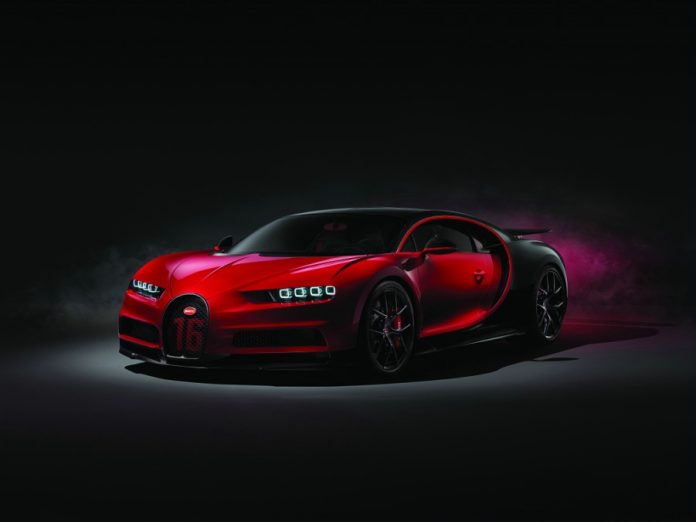The Bugatti Chiron Super Sport 300+ has just become the fastest production car in history. It’s not driving, it’s time traveling.
By Guilherme Marques

The desire to go faster and faster is something that will never get old. And as technology progresses and man’s technical ingenuity gets sharper, records are bound to be broken, even in an age where electric vehicles are taking over from internal combustion machines.
Whereas defining the best car in the world may be a subjective endeavour, defining the fastest is much easier. It’s a question of numbers: the bigger the number, the fastest the car. And Bugatti is (also) all about big numbers.
Just like the Veyron Super Sport before it, the new Chiron Super Sport 300+ has just teared down another wall and set a new milestone in the world of speed. A pre-production of the Super Sport became the first hyper sports car to break the magic barrier of 300 miles per hour. In old money, that means 482.80km/h. In one of the runs, the Bugatti was clocked at a remarkable 490.48km/h.
Stephan Winkelmann, President of Bugatti, expressed his feelings with a sense of pride: ‘Bugatti has once again shown what it’s capable of. With this new record of the Chiron we enter again uncharted territory. Never before has a series manufacturer reached this high speed. Our goal was to be the first ever to reach the magic 300-mile per-hour mark. We have now achieved this – making ourselves, the entire team and myself, incredibly proud.’
Also significant is the fact Bugatti will now focus its attention on different goals. Winkelmann again: ‘We have shown several times that we build the fastest cars in the world. Now Bugatti was first to exceed the 300mph – its name will go down in the history books and it will stay that way forever. However, our hyper sports cars are capable of more. They offer absolute exclusivity, luxury, unmatched beauty and a high level of automotive craftsmanship. We will concentrate even more on this in the future.’ Surely, I say, 490km/h is enough.
The chosen venue was none other than the Ehra-Lessien test track in Lower Saxony, Germany. Owned, just like Bugatti, by the Volkswagen Group, it is the only paved road on the planet where such a car could achieve this kind of speed. Located 50 metres above sea level, it poses some serious challenges due to higher air-density. The 21 kilometre three-lane highway is lined with crash barriers and rescue services are available at the north and south ends. Before the test, special mats were used to clean residues, stones and grit.
On August 2nd, Andy Wallace, Bugatti’s famous test driver, and winner of the 1998 Le Mans 24 Hours, looked to add another notch to his records belt. In 1998, Wallace reached 391km/h in a McLaren F1 on the same track, setting a record that stood until the Veyron smashed it to pieces in 2010 with a recorded run of 434km/h.
In Wallace’s own words: ‘An incredible speed. It’s inconceivable that a car would be capable of this. But the Chiron was well prepared and I felt very safe. Even at the first attempt I felt this would work. The Chiron ran perfectly and the track and weather conditions were ideal. The whole team did a fantastic job’.
After a warm-up lap, Wallace nudged 200km/h out of the north curve onto the 8.8 mile straight. For 70 seconds he kept the throttle to the floor, covering 136 metres per second at 300 mph. It’s not car travel, it’s time travel. The record run was recorded by a sealed GPS box, the certificate issued by SGS-TUV Saar.

But what about the car itself? Under the direction of Bugatti’s Head of Development Stefan Ellrott, and in partnership with Dallara and Michelin, a team of engineers from multiple disciplines prepared a pre-production unit of the Chiron Super Sport 300+ with increased safety features, including six-point belts and an additional safety cell. The drag at the rear was improved and aerodynamic stall reduced by over 40%. The body of the 300+ is made of exposed, jet-black carbon fibre adorned with Jet Orange racing stripes. Inside, the fastest Chiron of all is dominated by black carbon, leather and Alcantara in Beluga Black, complemented by colour highlights in Jet Orange. All interior trim parts have a black anodised finish.
The 300+ is the ultimate version of the Chiron, itself the ultimate in luxury and performance in the automotive world. Powered by a quad-turbo W-shaped 16 cylinder engine – basically two V8s bolted together – with 8 litres of capacity, the Super Sport produces 1600 horse power – 100 more than the regular car – and, Bugatti says, was developed to sustain constant traveling speeds above 420km/h. There are four banks of four cylinders sharing a common crankshaft; the upper two have a 90-degree angle, the lower ones 105. The four existing turbos work in groups of two. The first ones are constantly spinning, fed by eight exhausts to minimise lag, whereas the other two have dedicated waste valves that work depending on throttle position and rev range.

The Chiron is four-wheel drive and features a double-clutch transmission developed especially by British firm Ricardo. Performance is out of this world: beyond a world record top speed, 0-100km/h takes a face bending 2.5 seconds, 200km/h come up four seconds later and after 13.6 seconds the car will be showing 300km/h. The tyres, developed especially for the Chiron 300+ have to withstand 5300 G and still be street legal. At 300mph, they rotate at 4100 rpm. Taken to the limit, they can hold speeds of up to 511km/h. Michelin must be proud: the achievements of the Chiron, as of the Veyron before it, are only possible if tyre technology can keep up.
500 units of the Chiron will be built, including 30 Super Sport 300+. Depending on the market and the taxes, each Chiron costs something between €2.5M and €4M. Prices for the Super Sport hang around the €5M mark and they are likely all sold out.
More than just a car, the Chiron Super Sport 300+ is a piece of automotive artistry and very possibly the last purely internal combustion car to achieve such speeds without the help of some kind of electric aids. It is, therefore, a piece of history and Bugatti must be applauded for showing us what a team of determined people with one common goal can achieve.
That probably no Super Sport owner will ever achieve Wallace’s speed is beyond the point. Owning one is a bit like owning the intangible. One’s own private time machine.






























